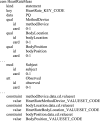Lessons learned in detailed clinical modeling at Intermountain Healthcare
- PMID: 24993546
- PMCID: PMC4215059
- DOI: 10.1136/amiajnl-2014-002875
Lessons learned in detailed clinical modeling at Intermountain Healthcare
Abstract
Background and objective: Intermountain Healthcare has a long history of using coded terminology and detailed clinical models (DCMs) to govern storage of clinical data to facilitate decision support and semantic interoperability. The latest iteration of DCMs at Intermountain is called the clinical element model (CEM). We describe the lessons learned from our CEM efforts with regard to subjective decisions a modeler frequently needs to make in creating a CEM. We present insights and guidelines, but also describe situations in which use cases conflict with the guidelines. We propose strategies that can help reconcile the conflicts. The hope is that these lessons will be helpful to others who are developing and maintaining DCMs in order to promote sharing and interoperability.
Methods: We have used the Clinical Element Modeling Language (CEML) to author approximately 5000 CEMs.
Results: Based on our experience, we have formulated guidelines to lead our modelers through the subjective decisions they need to make when authoring models. Reported here are guidelines regarding precoordination/postcoordination, dividing content between the model and the terminology, modeling logical attributes, and creating iso-semantic models. We place our lessons in context, exploring the potential benefits of an implementation layer, an iso-semantic modeling framework, and ontologic technologies.
Conclusions: We assert that detailed clinical models can advance interoperability and sharing, and that our guidelines, an implementation layer, and an iso-semantic framework will support our progress toward that goal.
Keywords: Health Information Systems/Standards; Information Storage and Retrieval; Medical Records Systems, Computerized/Standards; Semantics; Vocabulary, Controlled.
Published by the BMJ Publishing Group Limited. For permission to use (where not already granted under a licence) please go to http://group.bmj.com/group/rights-licensing/permissions.
Figures






References
-
- Huff SM, Rocha RA, Solbrig HR, et al. . Linking a medical vocabulary to a clinical data model using Abstract Syntax Notation 1. Methods Inf Med 1998;37:440–52 - PubMed
-
- Huff SM, Rocha RA, Coyle JF, et al. . Integrating detailed clinical models into application development tools. Stud Health Technol Inform 2004;107(Pt 2):1058–62 - PubMed
-
- Coyle JF, Rossi Mori A, Huff SM. Standards for detailed clinical models as the basis for medical data exchange and decision support. Int J Med Inform 2003;69:157–74 - PubMed
Publication types
MeSH terms
Grants and funding
LinkOut - more resources
Full Text Sources
Other Literature Sources

